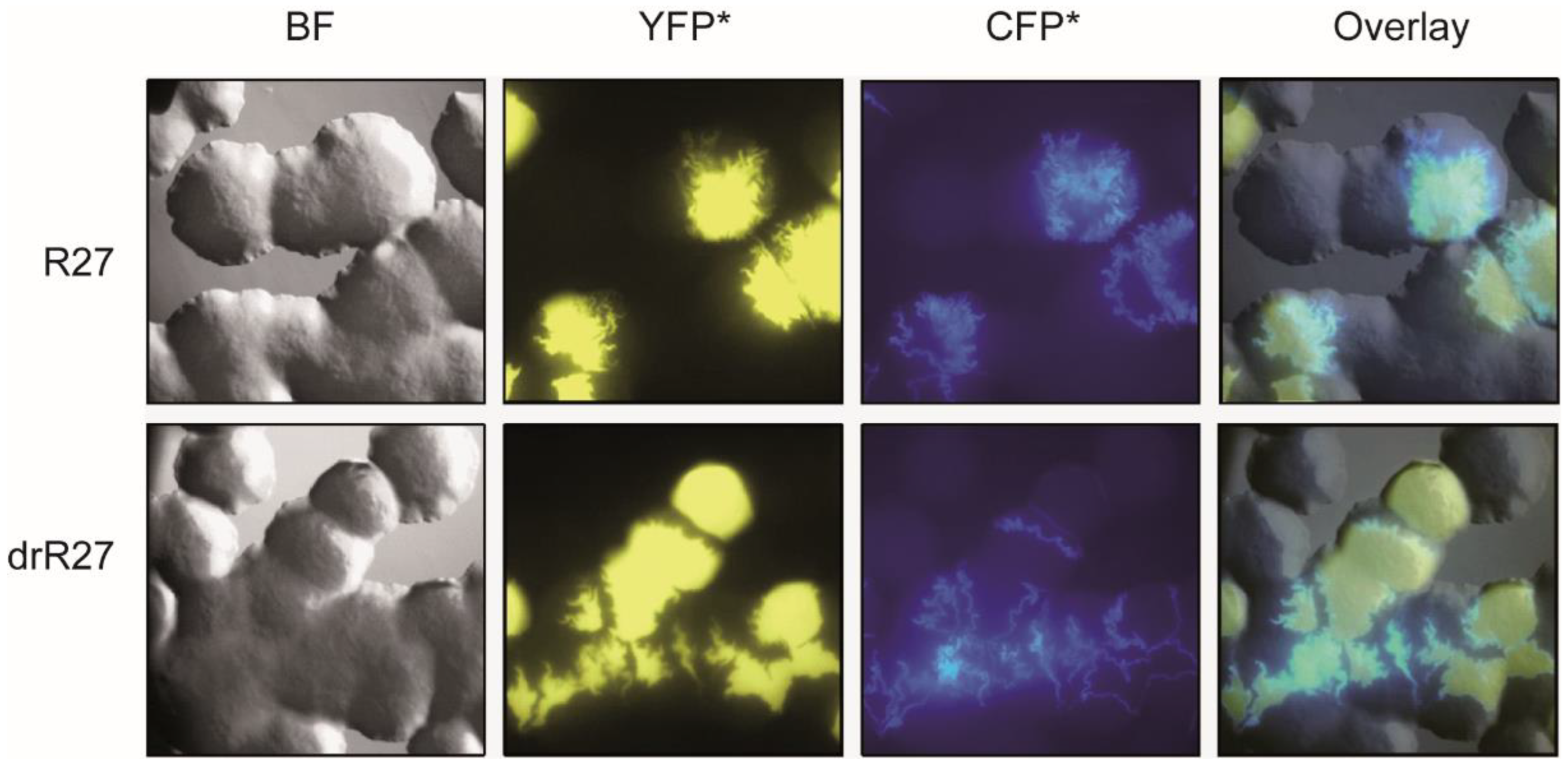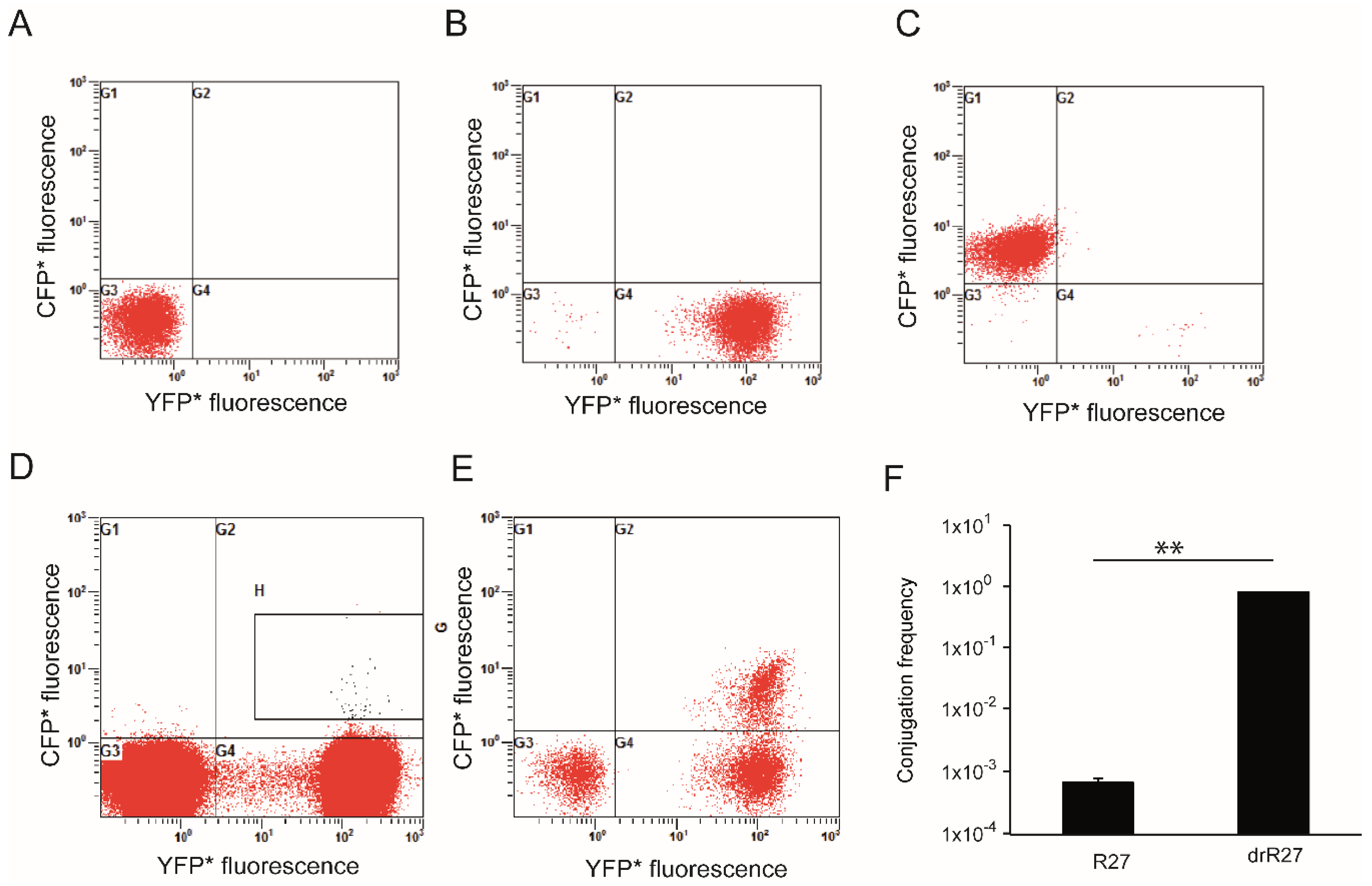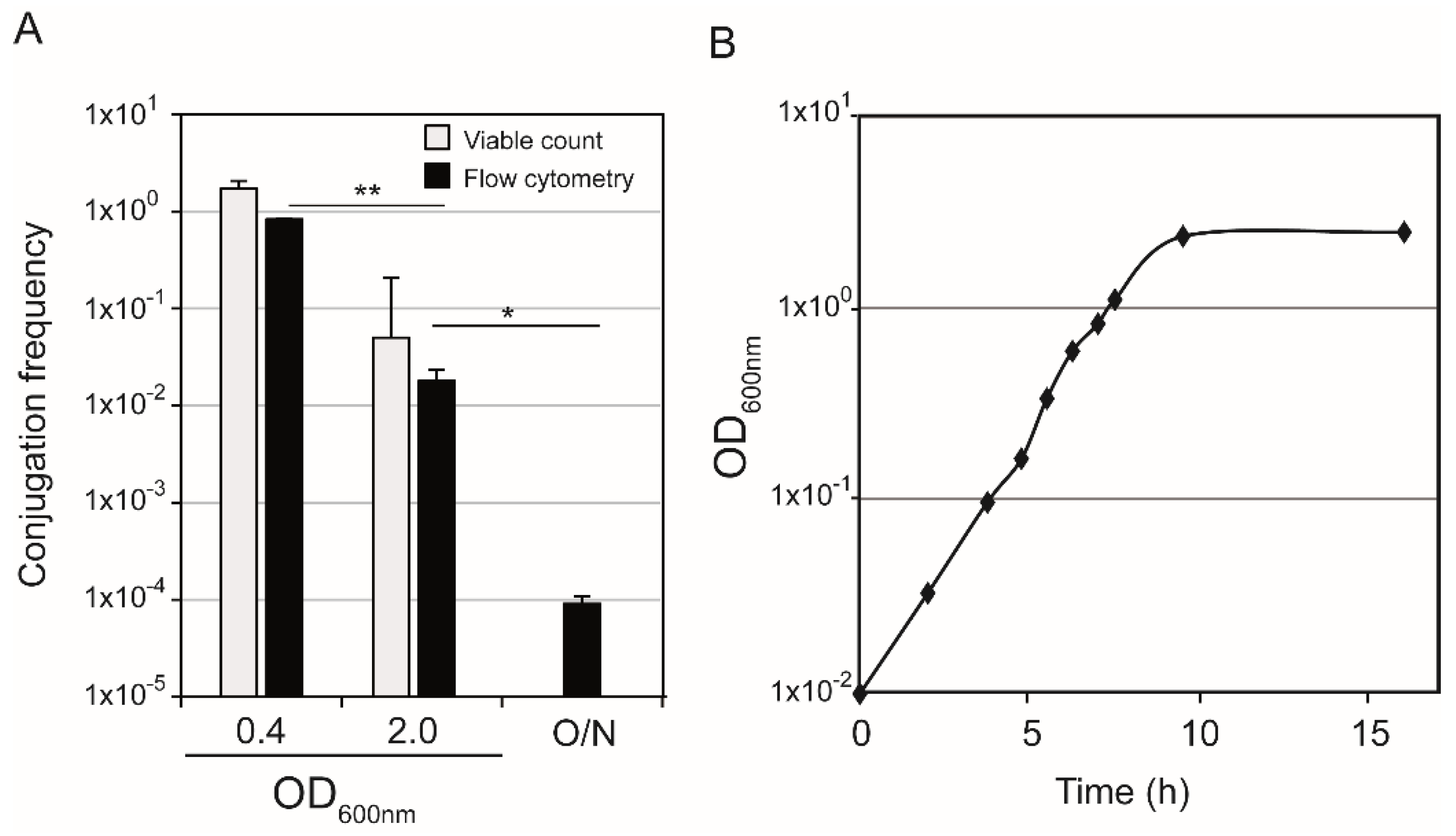In Situ Monitoring and Quantitative Determination of R27 Plasmid Conjugation
Abstract
1. Introduction
2. Materials and Methods
2.1. Bacterial Strains, Plasmids and Growth Conditions
2.2. Genetic Techniques
2.3. Conjugation Assays
2.4. Microscopy
2.5. Flow Cytometry Assays
2.6. Statistical Analysis
3. Results and Discussion
3.1. In Situ Monitoring of the R27 and drR27 Conjugation
3.2. Use of Flow Cytometry to Determine Conjugation Frequencies
3.3. Use of Flow Cytometry to Monitor the Frequency of drR27 Conjugation through the Growth Curve
4. Conclusions
Author Contributions
Funding
Institutional Review Board Statement
Informed Consent Statement
Data Availability Statement
Acknowledgments
Conflicts of Interest
References
- Wiedenbeck, J.; Cohan, F.M. Origins of bacterial diversity through horizontal genetic transfer and adaptation to new ecological niches. FEMS Microbiol. Rev. 2011, 35, 957–976. [Google Scholar] [CrossRef] [PubMed]
- Phan, M.-D.; Wain, J. IncHI plasmids, a dynamic link between resistance and pathogenicity. J. Infect. Dev. Ctries. 2008, 2, 272–278. [Google Scholar] [CrossRef] [PubMed]
- Holt, K.E.; Phan, M.D.; Baker, S.; Duy, P.T.; Nga, T.V.T.; Nair, S.; Turner, A.K.; Walsh, C.; Fanning, S.; Farrell-Ward, S.; et al. Emergence of a globally dominant IncHI1 plasmid type associated with multiple drug resistant typhoid. PLoS Negl. Trop. Dis. 2011, 5, e1245. [Google Scholar] [CrossRef] [PubMed]
- Taylor, D.E.; Levine, J.G. Studies of temperature-sensitive transfer and maintenance of H incompatibility group plasmids. J. Gen. Microbiol. 1980, 116, 475–484. [Google Scholar] [CrossRef] [PubMed]
- Gibert, M.; Paytubi, S.; Madrid, C.; Balsalobre, C. Temperature dependent control of the R27 conjugative plasmid genes. Front. Mol. Biosci. 2020, 7, 124. [Google Scholar] [CrossRef]
- Maher, D.; Taylor, D.E. Host range and transfer efficiency of incompatibility group HI plasmids. Can. J. Microbiol. 1993, 39, 581–587. [Google Scholar] [CrossRef] [PubMed]
- Gibert, M.; Paytubi, S.; Beltrán, S.; Juárez, A.; Balsalobre, C.; Madrid, C. Growth phase-dependent control of R27 conjugation is mediated by theinterplay between the plasmid-encoded regulatory circuit TrhR/TrhY-HtdA and the cAMP regulon. Environ. Microbiol. 2016, 18, 5277–5287. [Google Scholar] [CrossRef]
- Gibert, M.; Juárez, A.; Madrid, C.; Balsalobre, C. New insights in the role of HtdA in the regulation of R27 conjugation. Plasmid 2013, 70, 61–68. [Google Scholar] [CrossRef]
- Gibert, M.; Juárez, A.; Zechner, E.L.; Madrid, C.; Balsalobre, C. TrhR, TrhY and HtdA, a novel regulatory circuit that modulates conjugation of the IncHI plasmids. Mol. Microbiol. 2014, 94, 1146–1161. [Google Scholar] [CrossRef]
- Sørensen, S.J.; Bailey, M.; Hansen, L.H.; Kroer, N.; Wuertz, S. Studying plasmid horizontal transfer in situ: A critical review. Nat. Rev. Microbiol. 2005, 3, 700–710. [Google Scholar] [CrossRef]
- Christensen, B.B.; Sternberg, C.; Molin, S. Bacterial plasmid conjugation on semi-solid surfaces monitored with the green fluorescent protein (GFP) from Aequorea victoria as a marker. Gene 1996, 173, 59–65. [Google Scholar] [CrossRef]
- Krone, S.M.; Lu, R.; Fox, R.; Suzuki, H.; Top, E.M. Modelling the spatial dynamics of plasmid transfer and persistence. Microbiology 2007, 153, 2803–2816. [Google Scholar] [CrossRef][Green Version]
- Fox, R.E.; Zhong, X.; Krone, S.M.; Top, E.M. Spatial structure and nutrients promote invasion of IncP-1 plasmids in bacterial populations. ISME J. 2008, 2, 1024–1039. [Google Scholar] [CrossRef]
- Król, J.E.; Nguyen, H.D.; Rogers, L.M.; Beyenal, H.; Krone, S.M.; Top, E.M. Increased transfer of a multidrug resistance plasmid in Escherichia coli biofilms at the air-liquid interface. Appl. Environ. Microbiol. 2011, 77, 5079–5088. [Google Scholar] [CrossRef]
- Stalder, T.; Top, E. Plasmid transfer in biofilms: A perspective on limitations and opportunities. NPJ Biofilms Microbiomes 2016, 2, 1–5. [Google Scholar] [CrossRef]
- Reisner, A.; Wolinski, H.; Zechner, E.L. In situ monitoring of IncF plasmid transfer on semi-solid agar surfaces reveals a limited invasion of plasmids in recipient colonies. Plasmid 2012, 67, 155–161. [Google Scholar] [CrossRef]
- Guyer, M.S.; Reed, R.R.; Steitz, J.A.; Low, K.B. Identification of a sex-factor-affinity site in E. coli as Gamma Delta. Cold Spring Harb. Symp. Quant. Biol. 1981, 45 Pt 1, 135–140. [Google Scholar] [CrossRef] [PubMed]
- Aberg, A.; Shingler, V.; Balsalobre, C. Regulation of the fimB Promoter: A case of differential regulation by ppGpp and DksA in vivo. Mol. Microbiol. 2008, 67, 1223–1241. [Google Scholar] [CrossRef] [PubMed]
- Reisner, A.; Haagensen, J.A.J.; Schembri, M.A.; Zechner, E.L.; Molin, S. Development and maturation of Escherichia coli K-12 biofilms. Mol. Microbiol. 2003, 48, 933–946. [Google Scholar] [CrossRef] [PubMed]
- Reisner, A.; Molin, S.; Zechner, E.L. Recombinogenic engineering of conjugative plasmids with fluorescent marker cassettes. FEMS Microbiol. Ecol. 2002, 42, 251–259. [Google Scholar] [CrossRef]
- Grindley, N.D.; Grindley, J.N.; Anderson, E.S. R factor compatibility groups. Mol. Gen. Genet. 1972, 119, 287–297. [Google Scholar] [CrossRef] [PubMed]
- Sherlock, O.; Schembri, M.A.; Reisner, A.; Klemm, P. Novel roles for the AIDA adhesin from diarrheagenic Escherichia coli: Cell aggregation and biofilm formation. J. Bacteriol. 2004, 186, 8058–8065. [Google Scholar] [CrossRef] [PubMed]
- Whelan, K.F.; Maher, D.; Colleran, E.; Taylor, D.E. Genetic and nucleotide sequence analysis of the gene htdA, which regulates conjugal transfer of IncHI plasmids. J. Bacteriol. 1994, 176, 2242–2251. [Google Scholar] [CrossRef] [PubMed]
- Koraimann, G.; Teferle, K.; Markolin, G.; Woger, W.; Högenauer, G. The FinOP repressor system of plasmid R1: Analysis of the antisense RNA control of traJ expression and conjugative DNA transfer. Mol. Microbiol. 1996, 21, 811–821. [Google Scholar] [CrossRef] [PubMed]
- Camacho, E.M.; Serna, A.; Madrid, C.; Marqués, S.; Fernández, R.; de la Cruz, F.; Juárez, A.; Casadesús, J. Regulation of finP transcription by DNA adenine methylation in the virulence plasmid of Salmonella enterica. J. Bacteriol. 2005, 187, 5691–5699. [Google Scholar] [CrossRef]
- Frost, L.S.; Koraimann, G. Regulation of bacterial conjugation: Balancing opportunity with adversity. Future Microbiol. 2010, 5, 1057–1071. [Google Scholar] [CrossRef]
- Rozwandowicz, M.; Brouwer, M.S.M.; Fischer, J.; Wagenaar, J.A.; Gonzalez-Zorn, B.; Guerra, B.; Mevius, D.J.; Hordijk, J. Plasmids carrying antimicrobial resistance genes in Enterobacteriaceae. J. Antimicrob. Chemother. 2018, 73, 121–1137. [Google Scholar] [CrossRef]







| Strain/Plasmid | Description | Reference |
|---|---|---|
| MG1655 | F-, ilvG, rphI | [17] |
| AAG1 | MG1655 ΔlacZYA | [18] |
| SAR20 | CSH26 attBλ::bla-PA1/04/03-yfp*-To, AmpR | [19] |
| SAR08 | CSH26 attBλ::bla-lacIQ1, AmpR | [16] |
| DY330Nal | W3110 ΔlacU169 λcI857 Δ(cro-bioA), NalR | [20] |
| R27 | IncHI1 TcR | [21] |
| drR27 | R27 htdA::IS10 | [8] |
| R27-cfp* | R27 tet::cat PA1/04/03-cfp*-To | This work |
| drR27-cfp* | R27 htdA::IS10 tet::cat PA1/04/03-cfp*-To | This work |
| pAR92 | cat-PA1/04/03-cfp*-T0 cassette, AmpR, CmR | [20] |
| pAR179 | PrrnB-P1-dsred2.T3–T0 cassette, CmR | [22] |
| pAR65 | KmR vector | Reisner et al. unpublished |
| pAR179Km | pAR179 CmS KmR | This work |
Publisher’s Note: MDPI stays neutral with regard to jurisdictional claims in published maps and institutional affiliations. |
© 2022 by the authors. Licensee MDPI, Basel, Switzerland. This article is an open access article distributed under the terms and conditions of the Creative Commons Attribution (CC BY) license (https://creativecommons.org/licenses/by/4.0/).
Share and Cite
Gibert, M.; Jiménez, C.J.; Comas, J.; Zechner, E.L.; Madrid, C.; Balsalobre, C. In Situ Monitoring and Quantitative Determination of R27 Plasmid Conjugation. Life 2022, 12, 1212. https://doi.org/10.3390/life12081212
Gibert M, Jiménez CJ, Comas J, Zechner EL, Madrid C, Balsalobre C. In Situ Monitoring and Quantitative Determination of R27 Plasmid Conjugation. Life. 2022; 12(8):1212. https://doi.org/10.3390/life12081212
Chicago/Turabian StyleGibert, Marta, Carlos J. Jiménez, Jaume Comas, Ellen L. Zechner, Cristina Madrid, and Carlos Balsalobre. 2022. "In Situ Monitoring and Quantitative Determination of R27 Plasmid Conjugation" Life 12, no. 8: 1212. https://doi.org/10.3390/life12081212
APA StyleGibert, M., Jiménez, C. J., Comas, J., Zechner, E. L., Madrid, C., & Balsalobre, C. (2022). In Situ Monitoring and Quantitative Determination of R27 Plasmid Conjugation. Life, 12(8), 1212. https://doi.org/10.3390/life12081212






